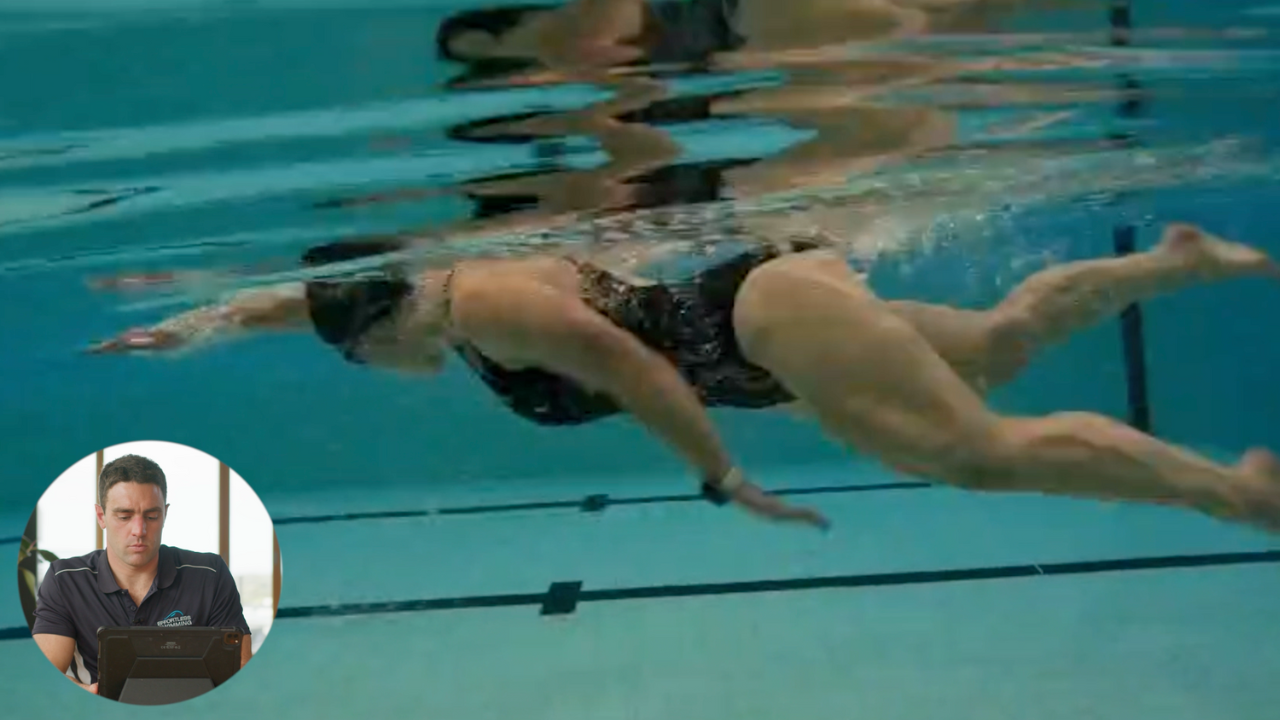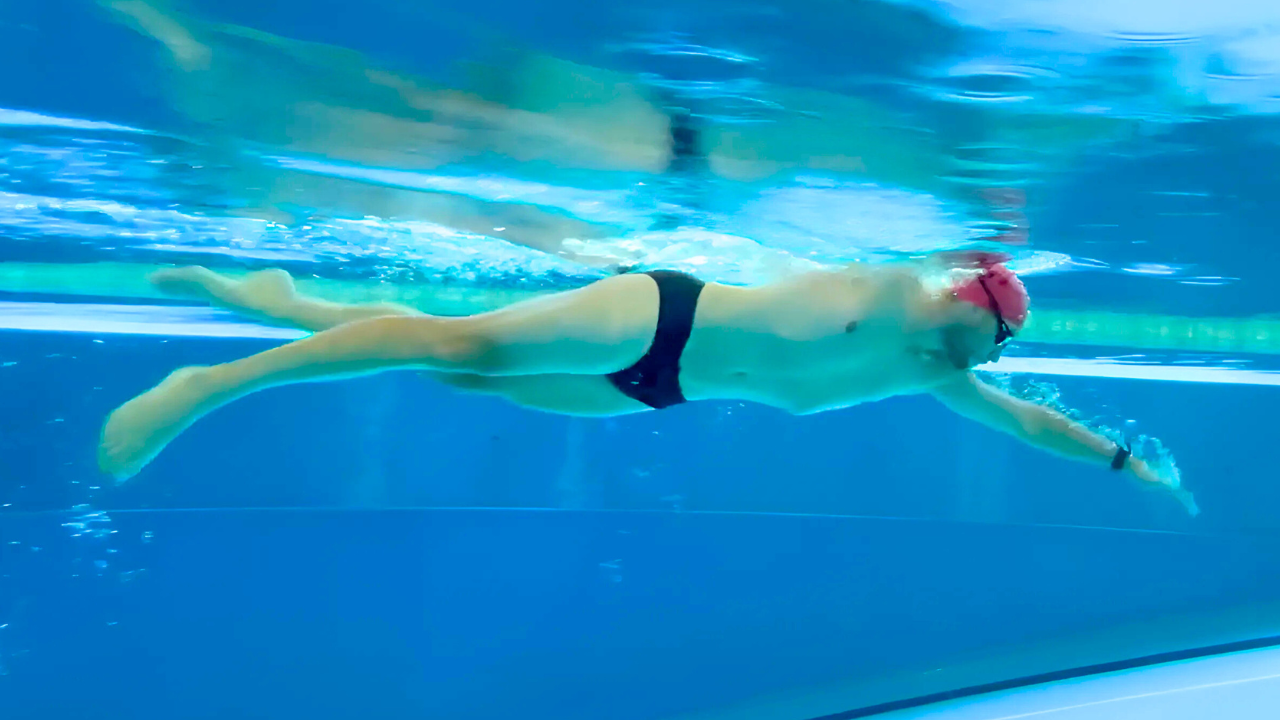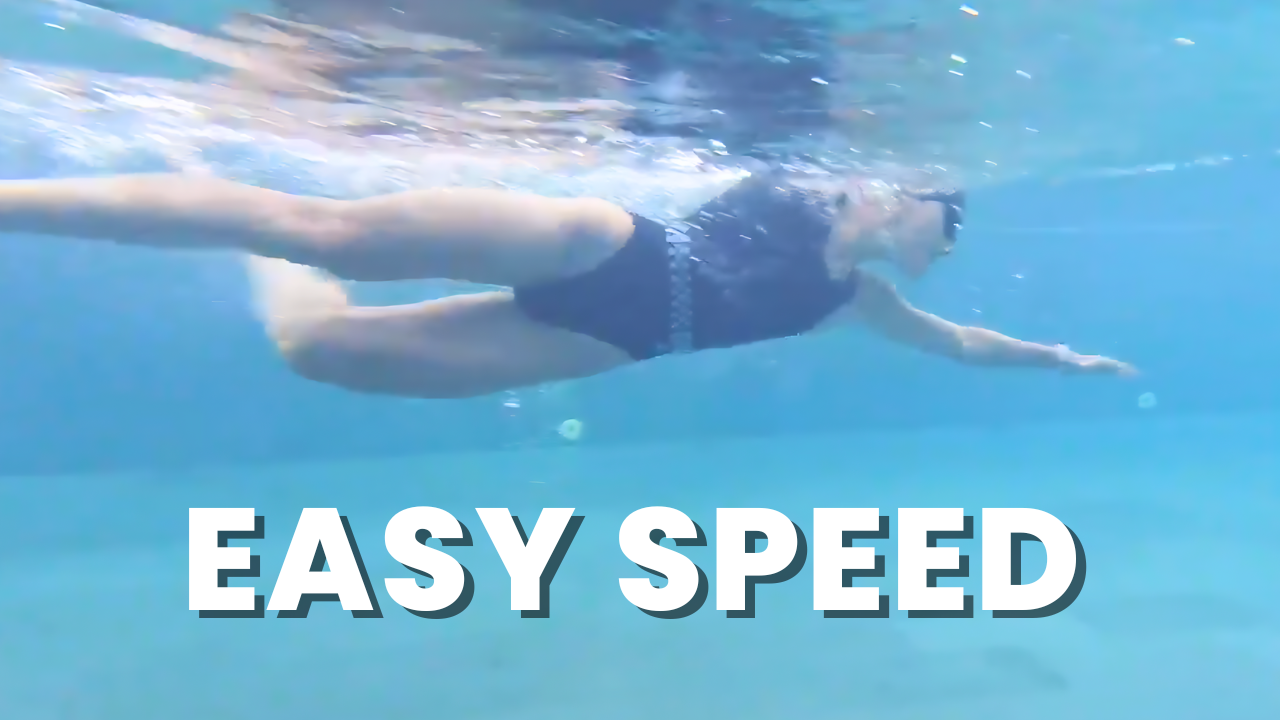We recently had triathlete Stephen Jackson on the podcast to share how he was able to improve by almost 40 seconds per 100m in 2 years.
Transcription:
Over the course of the next six to 12 months, I can see him getting it down to somewhere in the 130 range. Whether it’s 130s, 135s, that is certainly possible. Coming from a running background, that’s really impressive.
We recently had a guest on the podcast, Stephen Jackson. Stephen attended a clinic of ours about two and a half years ago. Since then, he’s been a member, where he’s been sending his videos quite regularly to work on his technique. We had him on the podcast where he spoke about, he was able to go 222 two and a half years ago. 220 pace for his Ironman swims and he’s now down to the mid 140s, which is a really good improvement, an improvement of about 35 seconds per 100 over the course of a roughly a half Ironman swim.
So, I’m going to show you some of the things that Stephen’s improved over that time and I’ll talk about how he went about improving those things. So the before shot, this is from two and a half years ago, mid-2017. You’ll see here that body position, the hips, and the legs are dropping quite a bit. So in terms of swinging fast, it’s very, very hard to swim with any sort of speed if the hips and the legs are dropping down that low.
There’s a number of things that were causing that to happen. So, one of them was head position. You’ll see that where he was looking there, just a little bit far forwards at times. So where he’s looking there, he could look a little bit further down. It wasn’t the main cause of it, not at all, but the head position was just the chin a little far forward. The other thing that was causing it was the kick, there wasn’t much of an upwards kick at all. So if you see the kick here, we get this upwards kick, but it doesn’t really come above the line of the hip.
So even though he’s kicking upwards here, that thigh, that quad is still lower than the hip. So what we want to try and do there is on some of those upwards kicks, just get the legs coming up a little bit higher. So that was one of the things that were causing it. So just a little bit low with the kick, so he wasn’t lifting up enough from the glutes and from the hips.
He was also exiting the water really short. So where this hand comes out, you’ll notice that, first of all, the hand turns into the body, so the palm of the hand’s facing in towards his hip, right there. So quite early on, and then the hand exits at the hip. Where we want to be is here where my mouse is, a little bit further past it. So in order to really get an extra 10%, 15% out of each stroke, that’s one of the things that we had to work on, is finishing further back past the hip and keeping the palm of the hand facing back for longer.
The other thing you’ll notice as we go through here is the catch. There wasn’t much of a catch happening, and part of that was the alignment. So when the hand was coming in, all right, fingers first, which is good. Then as he was going through, that first position, you’ll see that the fingertips are above the elbow. So he’s sort of dropping the elbow very early on, and from there, the hand just kept pressing down and we get to this dropped elbow catch position. So there wasn’t much of a catch happening.
Same on this right-hand side. This right arm’s crossing over, which I’ll show you in a moment. Fingers were coming up and the elbow was dropping. This is a really common thing for people who are sort of slower than the two minutes per 100 mark. So one of the things that can be worth checking if that is you, is when you enter, is your hand sliding forwards and are the fingers getting deeper than the rest of the arm? Just slightly deeper.
From there, you can just see that the hand was mostly pressing down. Fingers are facing forwards, pressing down to help them get the breath. So, he just wasn’t getting that much propulsion out of it. One of the things we worked on there is obviously changing it so that the fingers are deeper than the wrist, wrist below the elbow and exiting further past the hip. Because it’s those two things that work together.
Pressing back further past the hip, getting to about here and also getting this reach out in front where the hand’s in the right position, the arm’s in the right position, that’s where you get this nice distance per stroke. You get a little bit of extra glide, extra distance and that can really just help make things feel so much easier. It can make you feel like you’re going from swimming on a treadmill that you can’t get off to scaling from your left side to your right side. It can really make a difference there.
I’ll show you the front view because this is quite good to see. You get the left hand crossing over a lot and we’ll bring it up a little bit further as well. So left hand was really crossing the center and it was sort of shifting the head off to the side when he was breathing as well. That’s where we get the shoulders rotating a long way, all the way to 90 degrees, which is too far, we want to keep that to about 45 degrees. You can see what happened with the catch there, the arm is very straight, shoulders quite low, and so just not able to get a whole lot out of it. On that right-hand side, that the arms crossing well past the center and then it had to sort of make its way back out.
So there’s some of the sorts of flaws or the faults in the stroke that we’ve worked on over the last two and a half years. So let’s have a look at where it is today. So in terms of that alignment, that right side, it’s good. It’s entering in line with the shoulder, extending forwards. The thing that’s much more noticeable here is great … so much better here where the fingertips are below the wrist, wrist, below the elbow. Whereas before, those fingertips were up too high.
On the left-hand side, that one crosses over a bit, so there’s still a bit of crossover on some of these strokes. I’ll bring it back here. So he can still go a little bit wider, but as we come forward, you’ll see that the fingertips stay lower than the wrist and the elbow. So that’s so much better than having those fingers rise up and putting the brakes on.
The other thing you’ll notice here too is a much better angle with the catch. So before, that arm is going down straight and deep, now we’re starting to get a bit of bend in the elbow. Starting to get some of that power diamond, which we want to see and the catch is improving a lot. So we can still shift that out, and that’s what I talk about in his latest analysis. But so much better, and same here. So much better with this angle, getting towards that power diamond.
When we look at this angle at the elbow, it should be 100 to 120 degrees. I’m getting very close to that, I think it’s around about 130 there. So from the front, looking much better and from the side, you’ll notice what a difference this is too. So in terms of that body position, much higher, much less drag being created there. You’ll see that the heels were actually breaking the surface now.
So comparing this position to this position, you can see what a noticeable difference that is. It’s a combination of all of those different things that we ended up working on, and I’ll play it through here. Combination of each of those things. But you will see that what he does well here, and I’ll get it the closer angle because this is probably easier to see, is that, right, what happens out in front is a lot better here.
So on that breathing stroke, yeah, the hand comes up a little bit there, but pretty quickly, we get it to a much better position where the fingers are below the wrist, wrist below the elbow. Now we’ve got a bit of a catch on this arm, the elbow’s not dropping like it was. Left one there, good. Getting the fingertips to point down quite a bit more.
Now it looks here like he’s sort of dropped the elbow a bit, not necessarily the case because that left arm’s coming under the body a little bit too much. So once he shifts that out, it’ll start to move into a sort of a straight arm catch and eventually a higher elbow position. So even though it does look dropped, it’s not dropped per se, there’s just more because that arm’s come under the body. But here you can see what a better catch he gets on this right-hand side on that stroke there. Fingertips are pointing down, whereas before, they were really facing forwards most of the time.
Moving through there and exiting. Still exiting probably a little bit short on that stroke. He’s keeping the hand facing back behind him a little bit longer, but he could go slightly further back there. We talk about some of these things in the most recent analysis. That exit’s pretty close.
As you know, swimming is a process, so what we’ve worked on over the last two and a half years is each of these things. You’re not going to get all of these things right straight away, and sometimes some things will work well and then other things will start to sort of fall apart there, and we just want to sort of revisit them. That’s what we’ve found over those two and a half years is I’ve worked with Stephen, is that we’ll look at say the catch in the pool, we’ll practice a few different things with that, and then we might find that maybe the kickstarter to change. So we just start to refine them over that course of time.
The other thing that I think has made a big difference is patience in the catch. So you’ll see in this very first view, this before one, he’s really rushing out in front. There’s a lot of bubbles on the hand, he’s looking to start the catch in the pool as quickly as he possibly can. Whereas, what we’ve worked on here is just being more patient. So, slow to fast. You want the hands out in front to be a little bit slower than it is out the back.
So with that sort of patience with the catch, it just gives you the time to be able to connect everything up in the body, plus it can really bring the heart rate down. You notice that with his breathing too, it’s very … beforehand, it was very rushed with the breath, whereas now, he’s able to control that breath a whole lot more. That’s a big factor to swim 220s compared to 145s there.
So in terms of all right, well, these are the things that we’ve changed, what are some of the drills that we used to change some of these things? So, one of them was the tricep extension drill to help with pressing back and keeping the palm of the hand facing back for longer. So tricep extension drill, which you can see here. This is the drill that I like to use most of the time to help with the exit of the stroke.
With improving the body position, one of the things that we have done is just work on either your front kicking drill or your body position kick drill, where you’re looking to just exaggerate or sort of just be able to kick at the surface of the water. Also, just keeping the kick a little bit smoother and a little bit smaller as well. So, body position kick or front kick drill can be really good for working on that.
The other thing we worked on was on those breathing strokes, which you can see from the front, we don’t want to over-rotate. So we want to try and just make sure that the shoulder’s rotating to about sort of a 45 maximum, really 50 degrees on those breathing strokes. So one of the things that we practiced there was the FKB drill, which you’ve probably seen in some previous videos.
The last one. We’ve done a lot of different catch drills over that two and a half years, but now we’re just really working on the YMCA drills in order to continue to refine the catch in the pool. On a lot of strikes, he really gets a good catch on both sides, but particularly the right one. You can see how much better, like this position here, that shoulder is up near the side of the face. Great position to start the catch and see what’s happening there, he’s actually getting that high elbow position, which is a big, big difference.
So we’re using the YMCA drill progression to help with that now and just continue to refine the other parts of the stroke. So made a big, big difference here. As you can see, there are still things that we can do. Over the course of the next six to 12 months, I can see him getting it down to somewhere in the 130 range. Whether it’s 130s, 135s, that is certainly possible. Coming from a running background, that’s really impressive as well.
So if you haven’t heard the podcast, you can find our podcast by searching the Effortless Swimming Podcast and find Stephen’s episode there. We also do a podcast every single week. So thanks very much for watching and I hope you learned something from this video. Now, if you do want to work with me on your own stroke to improve your swimming, whether it’s open water, whether it’s for the pool or in triathlon, then you can join our stroke analysis membership. We’re currently open to new members. Find the link below in the description. I’m looking forward to working with you. I’ll see you next week.










